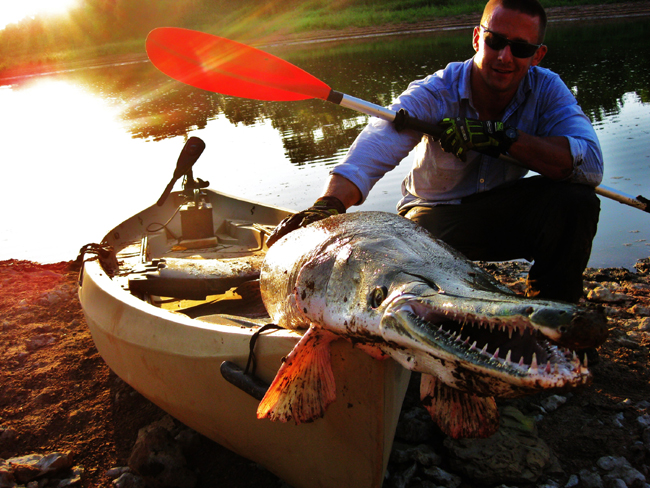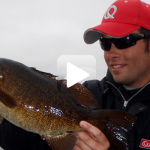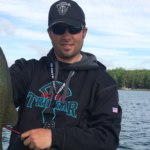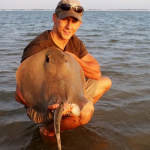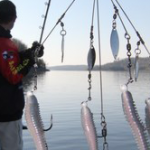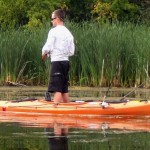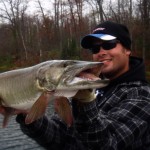By: David Graham – Date Posted: September 1, 2012
East Texas and Oklahoma are home to some of the largest fish in North America. During the last six months I divided my time between a new job opportunity and pursuing some of these outstanding, rugged fish. Even before relocating to Texas I had begun pondering hte possibility of encountering one particular fish – the primitive, spectacular Alligator Gar. This Gar is North America’s largest exclusively freshwater fish; however, I also planned to catch the buffalo species that I had been unable to pursue in South Carolina.
Fishing in the hot, dry areas of East Texas and Oklahoma present a trifecta of challenges – arid climate, very little water, but plenty of competitive outdoorsmen as intent as I am to land a trophy representative of these elusive fish. Through experience I’ve learned that competing with other anglers is not simply a matter of owning the fastest boat, the best global positioning systems, or any other ‘state-of-the-art’ fishing technology. I don’t have those things, and the option to “flex my muscle” on the water just wasn’t viable. What I did have was a willingness to venture into the hardest-to-reach stretches of remote water where the truly large fish lived in relative obscurity, even if it meant expanding nearly as much time getting there as time spent actually fishing.
‘Google Earth’ is arguably an underutilized tool for anglers searching for those hard to reach locations. Although one could spend hours scoping out ideal looking bends, river junctions, coves, and feeder creeks, what is needed is a lean, rugged means of transportation TO those prized spots. My goal was reaching ‘impenetrable’, secluded fishing habitats that are preferred by the massive Alligator Gar, and it has been my experience with these fish that the truly massive specimens simply don’t hang around areas that are frequented by people. I researched watercrafts with excellent durability and one that could be launched virtually anywhere with ease – a one-man watercraft with great stability.
I came across the NuCanoe Frontier 12 online. Despite the name, the vessel is more of a kayak in style and appearance. The Frontier 12 has incredible stability, so much that it seems to defy physics; the angler can stand on virtually any point of this craft with no fear of tipping over. The Frontier 12 has a gear vault, internal rod chamber, universal mounting docks for customization, and a motor mount. It seemed perfect for the type of fishing and navigation necessary to help me reach the places I had mapped out on Google Earth.

I tested the Frontier in an inaccessible bayou deep in South Texas about an hour’s drive from where I lived. Schwings Bayou is a small, virtually inaccessible bayou just outside of Tivoli Texas which runs parallel to the Guadalupe River. The river is only accessible to boats via private roads; even then, the river itself is choked out on each accessible end by hyacinth which had overgrown and blocked off any way for boaters to get to the deeper pools of water. I had passed this stretch of bayou several times on my way to another fishing location, and had observed, from the bridge, large gar as they surfaced. I was able to take the Frontier through mosquito-infested brush and mud and access the stretch of bayou where the fish were unlikely to have ever encountered boats or anglers. This was a great way to test a new product and method of reaching unspoiled fish and I did enjoy some of the first alligator gar action as a resident of Texas in Schwings Bayou via kayak.

It was a remote stretch of the Red River boarding Oklahoma and Texas that I really wanted to utilize the Frontier 12 however. My brother and I knew about an area along the Red River on a sharp bend adjacent to a steep rocky bluff where large alligator gar congregate in great numbers over a deep hole in the river. The Red River is very shallow, and often subject to dramatic changes in depth due to drought. During most of the hot summer months the Red River goes completely dry in some areas. As water levels begin to drop, large fish seek refuge in the scarce, isolated holes of deep water typically found by junctions or sharp river bends. One particular bend, more than 10 miles from the nearest launch point, lay between fallen timber and dried riverbed. I knew it would be nearly impossible to reach with a boat utilizing any sort of conventional motor.

However, there was access by old dirt ranch roads some two miles upriver from the location we had mapped. My brother Travis and I managed to reach a location along the Red River which was teeming with populations of unspoiled alligator gar, long nose gar, blue catfish, common carp and buffalo. It was simply a matter of packing necessary gear into the two kayaks and making a 2-mile paddle, or in my case, leisurely zipping down river with a mounted trolling motor.

Travis and I made several successful trips into the remote via kayak and canoe for some of the largest alligator gar and long nose gar I have ever seen. I owe these successful voyages almost entirely to the versatility of small watercraft which gave us the leverage to access the remote stretches of river inhabited by trophy-sized fish.


Fishing seems to have become an ‘arms race’ to some extent, wherein anglers ‘arm’ themselves with the latest, flashiest ‘gadgets’ available in the hope that this will provide an advantage against other anglers. There may be some truth in this, but to those of us less financially equipped, there remains the more fulfilling option of working a little harder and smarter to reach areas that others can’t or won’t. A simple canoe or kayak is ill-equipped to traverse water at 70 mph, but modern kayak models are becoming more geared towards rugged anglers. Nevertheless, most of these lightweight kayaks and canoes can be launched from a muddy embankment, dragged across dried riverbed, through the thickest cypress swamp to isolated pools, or off of sheer rock face by one person alone. To the hardy angler, the experience of capturing the fish of a lifetime extends beyond the moment the rod bends. The experience should fully define the word ‘adventure’, to include the preparation, timing and the travel to and from “the spot”. The perfect catch begins with the vision, and ends with the final release of the most magnificent freshwater fish in North America, not excluding the means by which an angler reached that destination.



